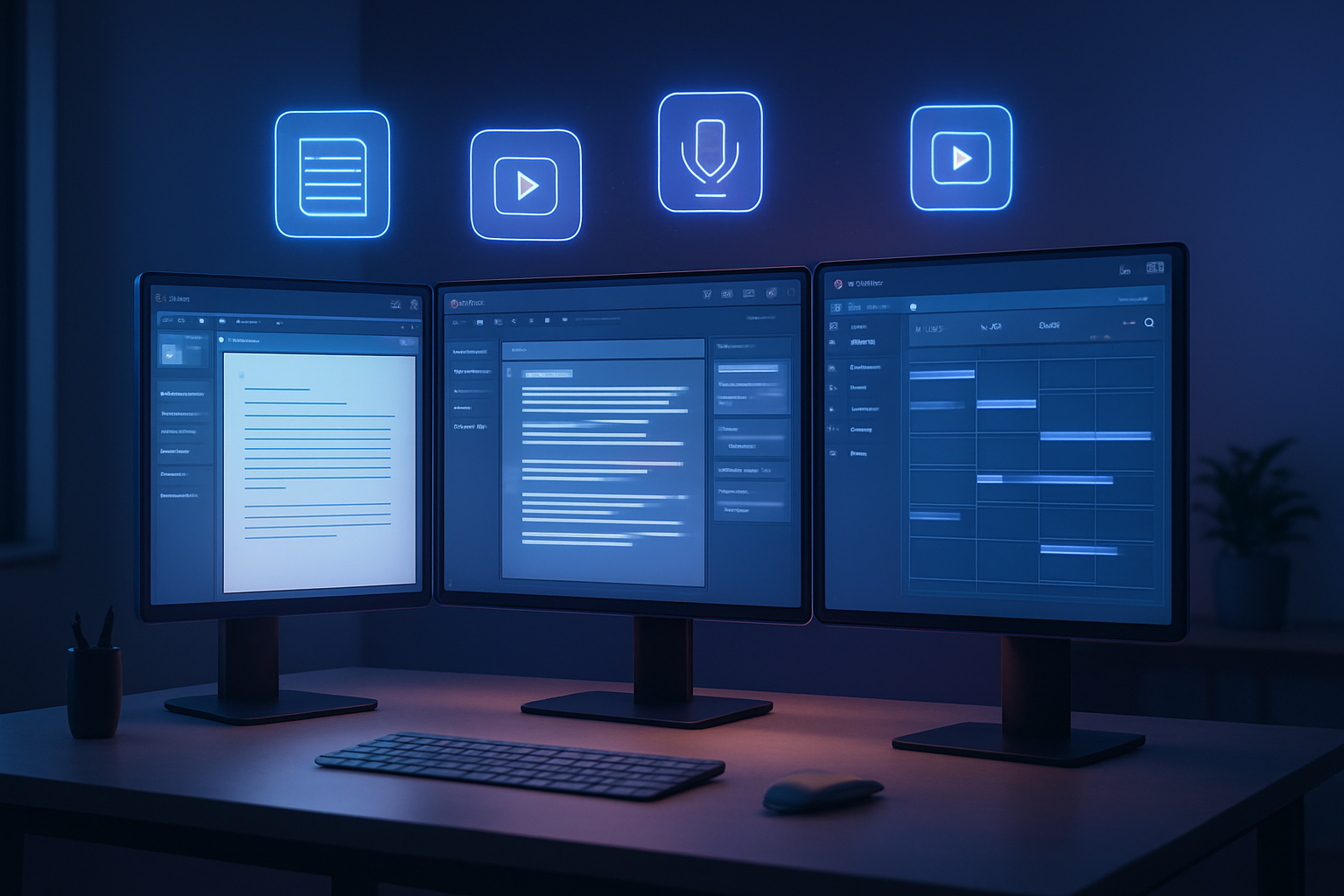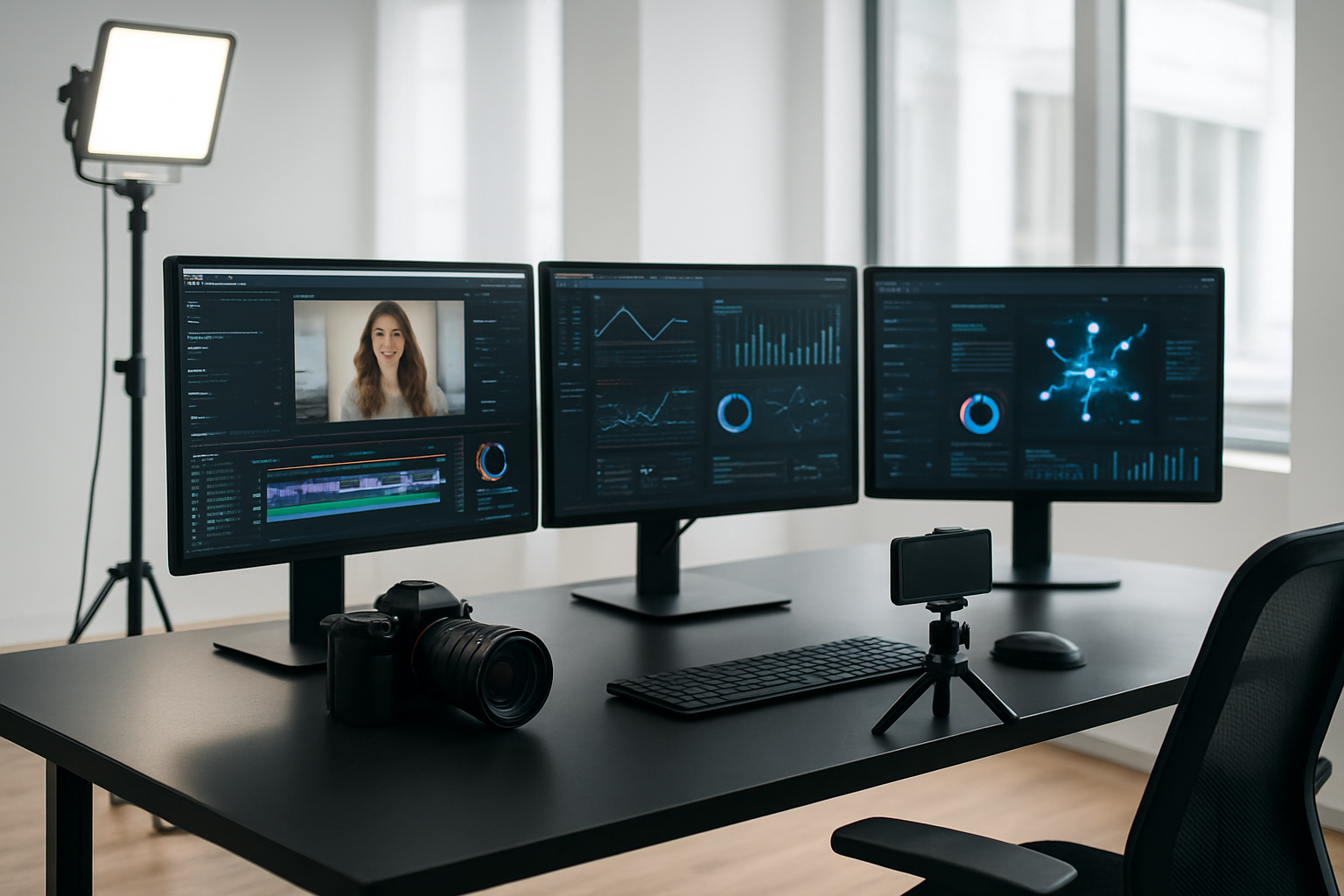
Content creators, marketers, and business owners are discovering that AI tools 2025 can finally handle the heavy lifting of content production. Instead of spending hours on repetitive tasks, you can now create professional videos, stunning visuals, and polished copy in minutes rather than days.
This guide is for busy professionals who want to streamline their content workflow without sacrificing quality. You’ll learn which AI content creation tools actually deliver results and how to integrate them into your daily routine.
We’ll explore AI video generators that produce professional content instantly, AI writing assistants that craft compelling copy, and AI automation tools that scale your entire content operation. You’ll also discover how AI image generators can transform your visual strategy and which productivity tools work best for different content types.
By the end, you’ll have a clear roadmap for choosing the right AI tools for your specific needs and budget.
AI Assistants That Handle Your Everyday Content Tasks

ChatGPT for Document Analysis and Quick Content Creation
ChatGPT stands as one of the most versatile AI writing assistants in 2025, offering powerful capabilities for both document analysis and rapid content generation. Its natural language processing technology understands and interprets human language with remarkable accuracy, making it an essential tool for content creators who need to generate high-quality material quickly and efficiently.
The platform excels at analyzing existing documents and extracting key insights, allowing users to upload files and receive comprehensive summaries, identify main themes, and generate actionable recommendations. This document analysis capability proves invaluable for content creators who need to process large volumes of research material or transform complex information into digestible content formats.
For quick content creation, ChatGPT’s strength lies in its ability to generate engaging, well-structured content across multiple formats. Whether you’re crafting blog posts, social media updates, email campaigns, or marketing copy, the AI can produce first drafts that maintain consistency and quality while significantly reducing time investment. The tool’s natural language generation capabilities ensure that content flows naturally and maintains reader engagement.
Claude for Advanced Coding and Technical Writing
Claude has established itself as the go-to AI assistant for advanced coding and technical writing tasks in 2025. Its sophisticated understanding of programming languages, technical concepts, and complex documentation makes it particularly valuable for developers, technical writers, and businesses requiring specialized content creation.
The platform’s strength in technical writing stems from its ability to maintain context across longer conversations and documents. This capability proves crucial when developing comprehensive technical documentation, API guides, or complex tutorials that require consistency and accuracy throughout lengthy documents. Claude can analyze existing codebases, explain complex functions, and generate documentation that bridges the gap between technical complexity and user comprehension.
For coding tasks, Claude offers intelligent code generation, debugging assistance, and optimization suggestions. It can work across multiple programming languages and frameworks, making it versatile enough to support diverse development teams and projects. The AI’s nuanced understanding of code structure and best practices ensures that generated solutions follow industry standards and maintain code quality.
Grok for Uncensored Content Generation with Real-Time Data
Grok distinguishes itself in the AI assistant landscape through its uncensored approach to content generation combined with real-time data access. This unique positioning makes it particularly valuable for content creators who need current information and unrestricted creative freedom in their AI-generated content.
The real-time data capability sets Grok apart from other AI tools that rely on training data with cutoff dates. Content creators can leverage this feature to generate articles, reports, and social media content that incorporates the latest trends, news, and market developments. This real-time access proves especially valuable for news organizations, marketing teams, and businesses that need to create timely, relevant content.
Grok’s uncensored approach allows for more creative freedom in content generation, enabling users to explore diverse perspectives and generate content on topics that might be restricted in other AI platforms. This flexibility makes it valuable for creative writers, journalists, and content creators who need to address complex or controversial subjects while maintaining factual accuracy.
Gemini for Large-Scale Content Processing and Audio Summaries
Gemini has positioned itself as the premier solution for large-scale content processing and multimedia content creation in 2025. Its advanced capabilities in handling extensive content volumes make it invaluable for enterprises and content creators who need to process and generate substantial amounts of material efficiently.
The platform’s large-scale content processing capabilities enable users to analyze thousands of documents simultaneously, extract patterns and insights, and generate comprehensive reports or summaries. This functionality proves essential for research teams, marketing departments, and businesses that need to process extensive data sets or content libraries to inform their content strategies.
Gemini’s audio summary feature represents a significant advancement in AI content creation tools. The platform can process audio content, including podcasts, interviews, and recorded meetings, and generate accurate text summaries that capture key points and insights. This capability streamlines workflows for content creators who work with multimedia content and need to repurpose audio materials into written formats.
The integration of these audio processing capabilities with traditional text generation makes Gemini particularly valuable for content teams that work across multiple media formats. Users can create comprehensive content strategies that incorporate insights from audio sources while generating written materials that maintain consistency across all content types.
AI Video Tools That Create Professional Content in Minutes

Synthesia for Avatar-Based Video Content Creation
Synthesia revolutionizes how content creators approach AI video tools in 2025 by eliminating the traditional barriers of video production. This AI-powered platform specializes in generating professional avatar-based videos without requiring cameras, lighting equipment, or filming crews—dramatically reducing both costs and production timelines.
The platform excels at creating AI avatars that deliver spot-on lip sync with incredibly natural facial expressions and body movements. When configured with the right settings, these AI-generated videos can appear almost as real as actual recordings, making them particularly valuable for businesses and motion designers seeking cost-effective video solutions.
For content creators, Synthesia opens up significant opportunities by replacing traditional video production elements that typically demand higher budgets and longer schedules. The tool proves especially effective for tech product demos, explainer videos, and educational content where AI avatars work seamlessly alongside motion graphics and animated visuals. Whether you’re working in 2D or 3D environments, Synthesia adapts to fit projects of varying complexity levels.
However, this powerful capability comes with notable trade-offs. Synthesia ranks among the most expensive AI tools available, which can be prohibitive for smaller content creators or agencies with limited budgets. Additionally, the platform’s built-in interface lacks user-friendly design elements, making navigation and customization more challenging than competitors.
Creating custom AI agents requires individual training for each different shot or angle, limiting the platform’s versatility for dynamic content production. Since Synthesia focuses primarily on avatar generation, its usage remains relatively narrow compared to more comprehensive AI video tools that offer broader functionality.
Google Veo for Creative Video Generation and Storytelling
Google Veo 3 stands out as the premier choice for end-to-end video generation among AI tools in 2025, transforming simple text prompts into high-quality finished products. This sophisticated platform combines three essential ingredients that make it particularly effective for creative storytelling and content marketing strategies.
The first ingredient centers on exceptional video output quality, rendering realistic settings and characters that surpass previous AI video generation standards. While Veo 3 still exhibits some AI telltale signs—including unusual camera movements, morphing objects, and occasional uncanny valley moments in human faces—it delivers significantly more convincing results than earlier AI video generators. Social media users frequently respond to Veo-generated content with surprise and engagement, often questioning whether the videos are authentic.
The second crucial element is native audio generation capability, allowing users to request any type of background soundtrack while Veo delivers accordingly. The platform’s standout feature enables users to write dialogue lines for each character, automatically generating voices with nearly perfect lip-sync performance. This native audio integration elevates the AI video aesthetic beyond simple voiceover additions, creating more polished, professional content.
The third ingredient involves Google’s AI filmmaking tool called Flow, which provides an intuitive editor interface. Flow maintains simplicity while offering sufficient advanced controls for outstanding results. Users can select between Fast and Quality model versions, utilizing tools to stitch multiple generations together through the scenebuilder feature for extended or transitional clips.
Access to Veo 3 requires subscription to paid Google AI plans, with no free access options available. The Google AI Pro plan costs $19.99 monthly, providing 1,000 credits with watermarked output, while the Ultra plan at $249.99 monthly offers 12,500 credits and removes watermarks. Brands increasingly utilize Veo-generated content for marketing strategy iterations and quick wins without hiring full production crews.
OpusClip for Automated Short-Form Video Creation from Long Content
With the growing demand for AI automation tools that scale content production, OpusClip addresses the specific challenge of transforming lengthy video content into engaging short-form clips suitable for social media platforms and modern content marketing strategies.
The platform specializes in automated video editing processes that identify the most engaging segments from longer content pieces, making it invaluable for content creators who need to maximize their existing video assets. This AI workflow automation capability significantly reduces the time and effort required to create multiple content variations from single source materials.
OpusClip’s automated approach to short-form video creation aligns perfectly with current social media trends, where platforms like TikTok, Instagram Reels, and YouTube Shorts dominate audience engagement. The tool’s ability to extract compelling moments from extended content helps creators maintain consistent posting schedules while ensuring each clip delivers maximum impact.
The platform’s automated editing features include intelligent scene selection, optimal timing adjustments, and format optimization for various social media platforms. This comprehensive approach to AI content creation tools ensures that creators can efficiently repurpose their long-form content without manually reviewing hours of footage or learning complex editing software.
For content creators and marketing teams managing multiple video assets, OpusClip represents a significant productivity enhancement. The tool’s automated workflow capabilities allow teams to scale their content production efforts while maintaining quality standards across all short-form video outputs, making it an essential component of modern AI-powered content strategies.
AI Image Generators That Transform Your Visual Content Strategy

Nano Banana for Quick Visual Edits and Social Media Graphics
Nano Banana stands out as the go-to AI image generator for Google users looking to streamline their visual content creation process. This powerful tool seamlessly integrates with Google’s ecosystem, making it incredibly accessible through Google Gemini and their API services. For content creators who are already embedded in Google’s workspace environment, Nano Banana offers unparalleled convenience and efficiency.
What makes Nano Banana particularly valuable for social media graphics is its user-friendly approach to AI image generation. The tool excels at taking text prompts and transforming them into high-quality visuals that are perfect for quick edits and social media applications. Whether you’re creating Instagram posts, Twitter graphics, or blog thumbnails, Nano Banana delivers consistent results without the complexity often associated with more advanced AI image generators.
The pricing structure makes Nano Banana accessible to a wide range of users. While it offers limited availability on the free plan, the full potential is unlocked with Google AI Pro plan at $20 per month. This subscription model is particularly attractive for businesses and content creators who are already investing in Google’s suite of productivity tools, as it provides comprehensive AI capabilities beyond just image generation.
GPT-4o for Royalty-Free Image Creation and Editing
GPT-4o has emerged as the best overall AI image generator, representing a significant leap forward from OpenAI’s previous DALL·E models. This multimodal AI tool has revolutionized how content creators approach royalty-free image creation and editing, offering unprecedented ease of use combined with exceptional quality results.
The standout feature of GPT-4o is its incredibly intuitive interface – users simply tell ChatGPT what they want to see, and it creates the image accordingly. This simplicity masks the sophisticated technology underneath, which excels at accurate text rendering, easy editing capabilities, and superior understanding of numbers and positioning within images. For content creators working on blog posts, marketing materials, or social media content, this level of precision is invaluable.
One of GPT-4o’s most impressive capabilities is its exceptional adherence to image prompts. Users can upload existing photos and direct the AI to recreate them in specific artistic styles, whether that’s Picasso, Vermeer, or Studio Ghibli aesthetics. This feature has contributed significantly to the tool’s viral popularity among content creators who need to maintain brand consistency while exploring creative variations.
The editing functionality sets GPT-4o apart from competitors. Users can request specific changes to individual elements within generated images, and the AI generally responds accurately to these modifications. This iterative approach to image creation allows for fine-tuning that was previously impossible with automated tools.
However, GPT-4o does have limitations that content creators should consider. The autoregression model, while producing superior results, operates significantly slower than diffusion-based competitors. Additionally, it generates only a single image per prompt, which may not suit workflows requiring multiple variations. The $20 monthly subscription for ChatGPT Plus is necessary for unlimited access, though free users can still access the tool with usage restrictions.
Midjourney for Artistic and Professional Visual Content
Now that we’ve explored user-friendly options, Midjourney represents the pinnacle of artistic AI image generation, specifically designed for creators who prioritize aesthetic excellence and professional-grade visual content. This platform has established itself as the premier choice for artistic results, offering capabilities that consistently produce stunning, gallery-worthy images.
Midjourney’s strength lies in its sophisticated understanding of artistic styles and techniques. The AI has been trained extensively on artistic works, enabling it to generate images with remarkable depth, composition, and visual appeal. For content creators working in creative industries, marketing agencies, or any field where visual impact is paramount, Midjourney delivers results that often surpass expectations.
The platform operates through both web app and Discord interfaces, providing flexibility for different user preferences and workflows. The Discord integration has fostered a vibrant community of creators who share techniques, prompts, and inspiration, making it an excellent resource for learning advanced AI image generation strategies.
From a pricing perspective, Midjourney offers excellent value starting at $10 per month for approximately 200 images per month, including commercial usage rights. This pricing structure makes it accessible for small businesses and individual creators while providing the licensing clarity necessary for professional applications.
The artistic capabilities of Midjourney make it particularly valuable for creating hero images for blog posts, stunning social media visuals, and professional presentations. The tool excels at understanding complex artistic concepts and can generate images that maintain consistent quality across various styles, from photorealistic renders to abstract artistic interpretations.
For content creators focused on building a strong visual brand identity, Midjourney’s artistic prowess provides the creative edge needed to stand out in crowded digital spaces. The combination of artistic excellence, commercial licensing, and active community support makes it an indispensable tool for serious visual content creation in 2025.
AI Meeting and Communication Tools That Boost Productivity

Fathom for Automated Meeting Documentation and Summaries
Fathom stands as a comprehensive AI-powered meeting assistant that seamlessly integrates with major meeting platforms including Zoom, Teams, and Google Meet. This productivity tool transcribes meetings in real-time and automatically generates detailed summaries to help professionals capture the most important discussion points without manual effort.
The platform’s core strength lies in its advanced AI capabilities that go beyond basic transcription. Fathom’s AI assistant analyzes meeting conversations and generates valuable insights, key takeaways, and even social media posts directly from the transcript content. This feature transforms raw meeting data into actionable content that can be immediately utilized across different business functions.
What sets Fathom apart in the AI meeting automation space is its accuracy and reliability. The tool provides structured transcriptions that can be enhanced with AI blocks and customizable templates, allowing users to maintain consistency across multiple meetings. These templates can be reused to add organizational structure to transcriptions, making it easier to locate specific information during follow-up reviews.
The automated summary feature ensures that all meeting participants receive comprehensive overviews of discussions, decisions made, and action items identified. This eliminates the common problem of important details slipping through organizational cracks and helps maintain accountability across teams.
Nyota for CRM Integration and Follow-Up Automation
Nyota delivers a comprehensive meeting management solution that extends far beyond traditional transcription services. This AI productivity tool provides users with a complete view of their meeting ecosystem from the moment they log in, offering intelligent organization and workflow automation capabilities.
The platform’s transcription engine captures meeting conversations and automatically generates detailed notes while summarizing key insights. One of Nyota’s standout features is its ability to group related topics covered across different meetings, creating a cohesive knowledge base that tracks ongoing discussions and project developments over time.
Nyota’s AI automation extends to proactive meeting preparation. The system analyzes topics covered in previous meetings and uses artificial intelligence to create agendas for upcoming sessions, ensuring continuity and comprehensive coverage of important subjects. This forward-thinking approach helps teams maintain momentum and ensures that critical discussions don’t get overlooked.
The platform’s daily workflow integration sends users morning emails containing their scheduled meetings along with AI-generated agendas. This proactive communication helps professionals prepare effectively and approach each meeting with clear objectives and context from previous discussions.
HubSpot AI Email Writer for Professional Email Content Creation
HubSpot’s AI Email Writer represents a significant advancement in professional communication automation, specifically designed to enhance follow-up processes after meetings and client interactions. This AI content creation tool integrates seamlessly with HubSpot’s CRM ecosystem, enabling users to generate professional, personalized email content that maintains consistency with their brand voice and messaging standards.
The AI writing assistant analyzes meeting context, participant information, and discussion outcomes to craft relevant follow-up emails that address specific points raised during conversations. This automation ensures that post-meeting communication is both timely and comprehensive, reducing the administrative burden on sales teams and project managers.
The tool’s integration with HubSpot’s broader platform allows for sophisticated personalization based on contact data, previous interactions, and relationship history. Users can generate email templates that incorporate meeting insights, action items, and next steps while maintaining a professional tone appropriate for different stakeholder relationships.
HubSpot’s AI Email Writer also supports various email types, from initial meeting requests to detailed project updates and client check-ins. The system can adapt writing styles based on recipient preferences and relationship dynamics, ensuring that communications feel authentic rather than automated. This capability proves particularly valuable for maintaining professional relationships and ensuring consistent follow-through on meeting commitments and project deliverables.
AI Automation and Workflow Tools That Scale Content Production

n8n for Visual Workflow Automation Without Coding
Previously, we’ve seen how AI assistants and video tools can transform individual content tasks. Now that we have covered these foundational AI tools, it’s time to explore how AI automation and workflow tools can scale your entire content production system. Visual workflow automation platforms like n8n represent a game-changing approach to building scalable AI content workflows without requiring extensive technical expertise.
n8n operates on the principle of treating workflows like software infrastructure with proper documentation, versioning, and monitoring capabilities. Unlike traditional automation tools that break under pressure at scale, n8n allows you to architect cohesive automation systems that integrate AI agents capable of making decisions rather than simply following basic triggers.
The platform excels at creating modular workflows where you can break complex content processes into composable modules. For instance, you might separate content ideation, generation, review routing, and publication into distinct workflow components. This modular approach prevents the shadow automations and unmonitored logic bugs that plague teams trying to scale their content operations.
What sets n8n apart is its ability to create event-driven systems that replace static if-this-then-that logic. Instead of rigid automation rules, you can build intelligent workflows that adapt based on content type, audience segment, or quality thresholds. The visual interface makes it possible for marketing teams to understand and modify workflows without depending entirely on technical resources.
Manus for Comprehensive AI Task Management and Content Generation
With this in mind, next we’ll examine how Manus transforms the entire content workflow from strategy to execution. While n8n handles the plumbing of automation, Manus serves as the intelligent orchestration layer that manages both AI-driven content creation and human oversight points.
Manus addresses one of the most critical bottlenecks in scaling content production: the subject matter expert review process. The platform implements what can be called the “reporter model,” where marketing teams function as journalists extracting expertise through brief interviews rather than waiting for lengthy review cycles. This cultural shift recognizes that having highly-paid professionals spend hours writing or reviewing articles creates an economically absurd bottleneck when a focused 10-minute interview can accomplish the same goal.
The platform manages the strategic framework that alternates between automation and human oversight at precisely the right moments. Stage one involves human strategy development where experts define editorial plans and business objectives. Stage two transitions to workflow automation where Manus handles project mapping, content generation triggers, and version control. Stage three returns to human creative review for brand voice and editorial judgment, while stages four and five manage production automation and final quality assurance.
Manus particularly excels at progressive trust building, starting with low-risk content that doesn’t require expert review—such as industry trend summaries and educational how-to content—then gradually expanding into more complex content types as teams demonstrate competency.
Baserow with AI Fields for Batch Content Creation at Scale
Now that we have covered individual workflow automation and comprehensive task management, let’s explore how Baserow with AI fields enables true batch content creation at scale. This combination represents the pinnacle of scalable content production, where database-driven content generation meets intelligent automation.
Baserow’s AI fields functionality transforms traditional content databases into intelligent content factories. Instead of manually creating each piece of content, teams can input structured data—topics, target keywords, audience segments, content types—and trigger batch generation processes that produce multiple content pieces simultaneously while maintaining consistency and quality standards.
The system implements the phased implementation approach essential for avoiding overwhelm when scaling content operations. Month one focuses on foundation and training, introducing core concepts and running practice sessions. Month two involves pilot production, typically doubling current output while monitoring friction points. Month three scales to target volume once workflows are smooth and teams are comfortable with the new processes.
This database-driven approach solves the fundamental challenge of scaling from 4 articles per month to 40 without creating backlogs that breed resentment. Baserow’s AI fields can generate content faster than teams can review it, but the system includes built-in throttling and human handoff points that prevent overwhelming review queues.
The platform excels at creating custom middleware that tracks AI decisions, logs every data exchange, and routes content with logic unique to your organization. This level of visibility and control becomes essential when handling high-volume content production while maintaining compliance and quality standards across your entire content operation.
AI Research and Knowledge Management Tools That Enhance Content Quality

Deep Research for Comprehensive Market Analysis and Reports
AI knowledge management tools are revolutionizing how organizations conduct deep research and compile comprehensive market analysis reports. These platforms leverage advanced artificial intelligence capabilities to transform scattered information into actionable intelligence that drives strategic decision-making.
Modern AI research tools excel at intelligent content management through automated deep indexing across multiple file types and storage locations. They can quickly locate exact phrases in text documents, slide decks, PDFs, video content, and audio files, dramatically reducing the time spent searching through company databases and ineffective enterprise search systems. This capability proves invaluable when conducting thorough market research where information often exists across various formats and platforms.
The power of AI-driven research lies in its ability to process and analyze vast amounts of unstructured data. Advanced platforms can automatically transcribe and highlight clips that match search terms in video and audio files, making it possible to extract insights from webinars, interviews, and recorded meetings that would otherwise remain buried in digital archives. This feature particularly benefits research teams analyzing competitor presentations, industry conferences, or customer feedback sessions.
AI research tools also provide automated tagging, summarization, and categorization of content at upload, streamlining the research process significantly. When conducting market analysis, these capabilities ensure that all relevant information is properly classified and easily retrievable, enabling researchers to build comprehensive reports without manually sorting through hundreds of documents.
The integration of generative AI takes research capabilities even further by automatically combining multiple contributions into linked series, creating connections between related pieces of information that might otherwise go unnoticed. This feature proves essential for identifying market trends, competitive patterns, and emerging opportunities across different data sources.
NotebookLM for Content Organization and Audio Summary Creation
NotebookLM represents a breakthrough in AI-powered content organization, offering sophisticated capabilities for transforming complex research materials into structured, accessible formats. This tool excels at processing large volumes of information and creating comprehensive audio summaries that make knowledge consumption more efficient and engaging.
The platform’s strength lies in its ability to understand context and relationships within documents, automatically organizing content in ways that support both individual research needs and team collaboration. By leveraging natural language processing, NotebookLM can identify key themes, extract crucial insights, and present information in formats that align with specific research objectives.
Audio summary creation represents a particularly innovative feature, allowing research teams to convert lengthy documents, reports, and analysis into digestible audio formats. This capability proves especially valuable for busy executives and team members who need to stay informed about market developments while managing demanding schedules. The AI ensures that critical insights aren’t lost in translation, maintaining the integrity and importance of key findings while making them accessible in new formats.
The tool’s content organization capabilities extend beyond simple document management. It creates intelligent connections between related pieces of information, helping researchers identify patterns and relationships that might not be immediately obvious. This feature becomes particularly powerful when analyzing market trends across different time periods or comparing competitive intelligence from various sources.
Notion Q&A for Knowledge Base Integration and Team Collaboration
Notion Q&A transforms traditional knowledge bases into intelligent, interactive systems that enhance team collaboration and knowledge sharing. This AI-powered feature creates a conversational interface that allows team members to ask questions using natural language and receive contextually relevant answers from the organization’s collective knowledge repository.
The system’s strength lies in its ability to understand conversational queries and propose answers from existing content within the platform, effectively avoiding the creation of duplicate questions while ensuring comprehensive coverage of topics. This capability proves essential for research teams working on complex market analysis projects where multiple team members may be seeking similar information from different perspectives.
Advanced question tracking and response time monitoring features ensure that knowledge gaps are quickly identified and addressed. The platform can nominate subject matter experts for specific topics, creating a structured approach to knowledge sharing that leverages individual expertise while building collective intelligence. This feature becomes particularly valuable when conducting comprehensive market research that requires input from specialists across different domains.
The collaborative aspects of Notion Q&A extend beyond simple question-and-answer functionality. The system learns from user interactions, continuously improving its ability to surface relevant information and suggest related content. This learning capability ensures that the knowledge base becomes more valuable over time, adapting to the team’s specific research patterns and information needs.
Integration capabilities with existing workflows and tools make Notion Q&A a seamless addition to research processes. Team members can access knowledge without disrupting their current workflows, while the system maintains a comprehensive record of all interactions for future reference and analysis. This integration approach ensures that valuable insights generated during research activities are captured and made available to the broader organization.
AI Writing and Design Tools That Elevate Content Creation

Rytr for Short-Form Content and Social Media Posts
Rytr stands out as one of the most versatile and budget-friendly AI writing tools for content creators who need to produce high-quality copy without breaking the bank. This AI copywriting tool excels at creating ads, blogs, social media posts, and various marketing materials with remarkable efficiency and affordability.
The platform provides an extensive library of templates designed for different content needs, including pitches, questions, song lyrics, replies, and SEO-optimized content. What makes Rytr particularly appealing is its customizable tone options and language support, allowing users to tailor their content to specific audiences and markets. The tool offers writing variants for each piece of content, giving creators multiple options to choose from and refine.
Rytr’s pricing structure makes it accessible to solo creators and small businesses. The free plan provides up to 10,000 words per month, which is generous for testing the platform’s capabilities. For users requiring more extensive usage, the Unlimited plan at $7.50 per month and Premium plan at $24.17 per month offer exceptional value compared to other AI content creation tools in the market.
The platform’s strength lies in its ability to generate punchy, engaging short-form content quickly. Social media managers particularly benefit from Rytr’s capacity to produce multiple variations of posts, captions, and ad copy, enabling A/B testing and content optimization strategies that drive engagement and conversions.
Sudowrite for Creative Writing and Overcoming Writer’s Block
For creative writers seeking AI assistance that understands the art of storytelling, Sudowrite represents a revolutionary approach to AI-powered writing tools. Unlike marketing-focused platforms, Sudowrite was designed specifically by writers for writers, addressing the unique challenges faced by novelists, screenwriters, and creative content creators.
The platform’s signature ‘Write’ button functionality analyzes existing text and continues it in the author’s established style. Writers can guide the AI with simple instructions like ‘show, don’t tell’ or ‘make it more suspenseful,’ creating a collaborative writing experience rather than mechanical text generation. This approach feels less like commanding a machine and more like working with a knowledgeable writing partner.
Sudowrite’s brainstorming tools are where the platform truly excels. Features like ‘Twist,’ ‘Character,’ and ‘Worldbuilding’ generate dozens of creative ideas based on user inputs, from character flaws and motivations to entire magic systems and plot developments. These tools prove invaluable for overcoming writer’s block and exploring new narrative directions.
The ‘Describe’ feature addresses one of creative writing’s most challenging aspects: creating vivid, sensory-rich scenes. This tool takes simple concepts and generates detailed descriptions incorporating sight, sound, smell, taste, and touch elements. It functions like an advanced thesaurus for imagery, helping writers craft immersive environments without falling into generic description patterns.
While Sudowrite excels at creative writing, it’s specifically designed for narrative fiction and shouldn’t be used for business reports, technical articles, or other non-fiction content. Writers must also be mindful of the platform’s tendency toward elaborate, sometimes overly flowery language that may require editorial restraint.
Canva Magic Studio for Template Generation and Visual Content Design
Canva Magic Studio represents a significant advancement in AI-powered design tools, transforming how content creators approach visual content production. This comprehensive platform integrates artificial intelligence throughout the design process, making professional-quality visual content accessible to users regardless of their design experience.
The Magic Studio’s template generation capabilities leverage AI to create custom designs based on user inputs and brand requirements. Instead of starting with blank canvases, creators can describe their vision, and the AI generates multiple template options tailored to their specific needs. This functionality proves particularly valuable for maintaining brand consistency across various content formats while reducing design time significantly.
The platform’s AI-powered features extend beyond simple template creation. Magic Studio includes intelligent color palette suggestions, font pairing recommendations, and layout optimization tools that ensure visual hierarchy and readability. These features help content creators produce professional-looking designs without extensive design knowledge or training.
For content creators managing multiple brands or clients, Magic Studio’s ability to learn and adapt to different brand guidelines streamlines the creative process. The AI remembers brand colors, fonts, and style preferences, automatically applying them to new designs and maintaining consistency across all visual content.
The integration of AI automation tools within Canva Magic Studio enables batch processing of designs, allowing users to create multiple variations of social media posts, presentations, or marketing materials simultaneously. This capability proves essential for content creators managing high-volume publication schedules across multiple platforms.
Gamma for AI-Powered Presentation Creation
Gamma revolutionizes presentation creation by applying artificial intelligence to streamline the entire process from concept to final slides. This innovative platform addresses the time-consuming nature of traditional presentation software by automating design decisions and content organization while maintaining professional quality standards.
The AI-powered presentation creation process begins with simple text inputs or outlines. Users provide their key points, and Gamma’s AI transforms this information into visually appealing, well-structured presentations complete with appropriate layouts, color schemes, and formatting. This automation eliminates the tedious aspects of slide creation while ensuring consistent visual quality throughout the presentation.
Gamma’s intelligent design system automatically selects appropriate layouts for different content types, whether displaying data visualizations, text-heavy slides, or image-focused presentations. The AI considers content hierarchy, readability, and visual balance to create presentations that effectively communicate the intended message.
The platform’s collaborative features enable teams to work together seamlessly, with AI assistance ensuring consistency across multiple contributors’ work. This capability proves particularly valuable for organizations requiring standardized presentation formats while allowing individual creativity and customization.
With AI workflow automation becoming increasingly important for content creators, Gamma represents the evolution of presentation tools from manual design processes to intelligent, automated systems. The platform reduces the time investment required for creating professional presentations while maintaining the quality standards expected in business and educational environments.
Now that we’ve explored these specialized AI writing and design tools, it becomes clear that the landscape of content creation is rapidly evolving toward more sophisticated, task-specific solutions that enhance rather than replace human creativity and strategic thinking.
AI Search and Voice Tools That Expand Content Capabilities

Perplexity and ChatGPT Search for Research-Backed Content
Now that we have covered workflow automation tools, let’s explore how AI search tools are revolutionizing content research and creation. Advanced AI search platforms like Perplexity and ChatGPT Search are transforming how content creators conduct research and develop voice-optimized material.
These AI-powered search tools excel at understanding conversational queries and natural language patterns, making them invaluable for creating content that performs well in voice search environments. With over 50% of searches expected to be voice-driven by 2025, content creators need tools that can bridge the gap between traditional keyword research and conversational search behavior.
ChatGPT Search capabilities extend far beyond simple query responses. When tasked with voice search research, it can generate extensive lists of conversational queries that mirror real user behavior. For instance, instead of focusing on keyword-heavy phrases like “video conferencing software features,” ChatGPT can generate natural voice queries such as “What’s the cheapest video conferencing tool that doesn’t require downloads?” or “Which video conferencing software works best for people who aren’t tech-savvy?”
The power of these AI search tools lies in their ability to simulate actual voice search patterns. They understand that people don’t speak in keywords—they ask complete questions using natural language. This insight helps content creators develop FAQ sections, conversational blog posts, and schema markup that voice assistants can easily parse and cite as authoritative answers.
Perplexity and ChatGPT Search also excel at semantic relationship mapping, helping creators understand how voice assistants connect related topics and queries. This capability enables the development of comprehensive content that addresses not just primary questions but also the related inquiries that naturally follow in conversational searches.
ElevenLabs for Natural Voice Synthesis and Audio Content
With voice search optimization established, the next frontier involves creating actual audio content that resonates with audiences. ElevenLabs represents a breakthrough in natural voice synthesis technology, enabling content creators to transform written material into professional-quality audio content without traditional recording requirements.
This AI-powered voice synthesis tool addresses the growing demand for audio content across platforms. As voice interactions become more prevalent, having the ability to create natural-sounding voiceovers, podcasts, and audio versions of written content becomes increasingly valuable for content strategy.
ElevenLabs’ advanced neural networks can replicate human speech patterns with remarkable accuracy, including emotional inflection, pacing, and natural breathing patterns. This level of sophistication means content creators can produce audio content that doesn’t sound robotic or artificial—a critical factor for maintaining audience engagement and credibility.
The tool’s versatility extends to multiple languages and voice styles, allowing creators to adapt content for different demographics and markets. Whether developing educational content, marketing materials, or accessibility features, ElevenLabs provides the voice synthesis capabilities needed to expand content reach and effectiveness.
Suno and Udio for Royalty-Free Music Generation
Previously, we’ve seen how voice synthesis transforms content creation, and now we’ll explore how AI music generation completes the audio content ecosystem. Suno and Udio represent cutting-edge AI music generation platforms that create original, royalty-free music for content projects.
These AI tools solve a persistent challenge for content creators: finding high-quality background music that doesn’t require expensive licensing fees or create copyright complications. Traditional music licensing can be prohibitively expensive for individual creators and small businesses, making these AI-generated alternatives particularly valuable.
Suno and Udio utilize advanced machine learning algorithms to compose original music across various genres and styles. The generated tracks maintain professional quality while being completely original, eliminating concerns about copyright infringement or licensing restrictions that often limit creative freedom in content production.
The platforms offer extensive customization options, allowing creators to specify mood, tempo, instrumentation, and duration to match their specific content needs. Whether creating background music for videos, podcast intros, or promotional content, these AI tools provide the flexibility to generate music that perfectly complements the intended message and audience.
With this in mind, next, we’ll see how the combination of AI search capabilities, voice synthesis, and music generation creates a comprehensive audio content ecosystem. Content creators can now research voice-optimized topics, convert written content to natural speech, and add professional background music—all using AI tools that deliver professional results without traditional production costs or licensing complexities.
These AI search and voice tools represent more than technological advancement; they signify a fundamental shift toward conversational, audio-first content strategies that align with evolving user preferences and search behaviors.

The AI revolution in content creation is no longer a future promise—it’s happening right now in 2025. From AI assistants like ChatGPT and Claude that handle your everyday writing tasks, to video generators like Synthesia and OpusClip that create professional content in minutes, these tools are transforming how we produce and manage content. Whether you’re using image generators like Midjourney for visual content, meeting assistants like Fathom for productivity, or automation tools like n8n for scaling your workflow, AI is making high-quality content creation accessible to everyone.
The key to success lies in choosing the right combination of tools for your specific needs. As users have proven with tools like OpusClip for daily video editing and ChatGPT for metadata and summaries, the most effective approach is integrating AI tools into your existing workflow rather than completely overhauling your process. Start with one or two tools that address your biggest content challenges, experiment with their capabilities, and gradually expand your AI toolkit as you discover what works best for your content strategy. The future of content creation is AI-powered, and these tools are your gateway to producing more, faster, and better than ever before.

